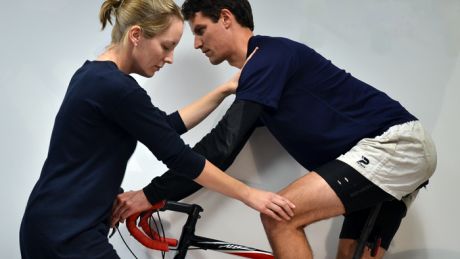How to prevent cycling injuries
Physiotherapist Lucy Macdonald outlines some common cycling injuries and explains what you can do to prevent them

The repetitive nature of cycling means that even a few millimetres of alignment adjustment can have significant effect on performance, get rid of a niggling pain and even prevent injury. Here are some of the common alignment faults and how to correct them.
Lower back
The lower back is often too flexed in cyclists, and this can cause damage to your spinal structure. From a performance perspective, having your back in this position means your glutes are unable to contract optimally. Since these buttock muscles are heavily involved in the cycling movements, this reduces power and speed.
The solutions
- Increase hip flexion, ie concentrate on bending more from your hips.
- Train the deep stability muscles that hold your spine in the correct position. This back exercise is particularly useful.
- Check your saddle height. If it is too high your pelvis will sway from side to side, increasing the strain on your back and reducing power over time.
Knees
Your knees should track directly over the centres of your feet. If they don’t, an imbalance is caused in your quads which results in knee pain. This is often caused by weak glutes and is again associated with reduced power.
The solutions
- Look down at your knees and if they are not moving over the centre of your feet simply adjust their position until they do.
- Incorporate glute strengthening into your training programme and stretch your quads and hamstrings, since problems with these can also contribute to knee pain. I recommend these stretching exercises.
- Make sure your seat is not too low because this causes a reduction in power and excessive loading to your knees.
- Incorrect foot posture, eg flat feet, can cause imbalances in your leg and back muscles resulting in knee pain and loss of power. This can be corrected with insoles, cleat wedges and by adjusting your cleat angle.
Neck and shoulders
Excessive curvature of your upper back and hingeing at the neck causes compression in the structures of your neck. This can cause pain in your neck, head, upper back and shoulders, which in turn can lead to pain, numbness and tingling in your arms.
The solution
- Focus on elongating your neck and upper back.
- Mobilising your upper back can help by a combination of hands-on physio and by doing thoracic spine exercises.
- Training your neck muscles can also help. Try these neck exercises.
- Make sure your elbows are ‘soft’, ie very slightly bent to provide shock absorbency and reduce the strain through your neck.
For advice on pain or injuries contact Lucy Macdonald at lucy@octopusclinic.com or go to octopusclinic.com.
Get the Coach Newsletter
Sign up for workout ideas, training advice, reviews of the latest gear and more.
Coach is a health and fitness title. This byline is used for posting sponsored content, book extracts and the like. It is also used as a placeholder for articles published a long time ago when the original author is unclear. You can find out more about this publication and find the contact details of the editorial team on the About Us page.

